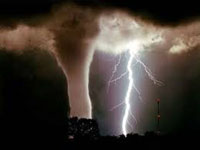Another Vizzed member asked me to explain the Saharan Dust Layer. I decided I would go into more detail about this natural meteorological event. Basically, this event needed it is own thread, so lets learn about the Saharan Dust.
First what is Saharan Dust? Saharan Dust is dust that comes from the Saharan Desert in Africa. It is common across the Atlantic Basin in June and July.
The dust is blown from the Sahara Dust by trade wins. These trade wins are sometimes called pre monsoon winds. As they occur before the monsoon season in the Sub-Saharan part of Africa. The trade wins combined with the jet stream carry the dust particles high up into the atmosphere.
The dust can be several miles into the atmosphere. This is why the dust does not settle down at the surface. Therefore, this is how the dust reaches the United States. Now, if the dust runs into mountains it will settle. Sometimes in towns near mountains they describe seeing tiny grains of sand on objects.
However, in the United States if its a brownish/tan color after it rains in the eastern part of the country. That is likely Saharan Dust that has been flushed out by thunderstorms. As thunderstorms can build several miles in the atmosphere. The precipitation from the storms helps dispense the dust.
The Dust though keeps tropical development down in the far Atlantic for the months of June and July. The dust creates very dry air so tropical systems would have a hard time developing. Remember, tropical systems need to have warm water temperatures of at least 80°F (27°C), no shearing winds and moist atmosphere to develop. The dust causes very dry air and would be developing systems have a hard time. Moreover, this is why usually for June and July we see development in the Gulf of Mexico or Caribbean
Now usually in August the Monsoon arrives full throttle. This is when the Saharan Dust Layer starts to fizzle out and stops blowing. August, September and even October is when we see development in the Far Atlantic as tropical waves come off the coast of Africa. On the other hand, if there is a severe drought in the Sub Saharan region of Africa the Monsoon may not be as active. In this cause dust plums would continue to blow across the Atlantic.
It should be noted sometimes the Monsoon can arrive early. When the Monsoon arrives early the dust stops blowing off the desert. This is why 1995, 1996, 2008, 2010, 2017, and 2020 saw tropical development in the far Atlantic in July. As the Monsoon arrived early in those years allowing tropical waves to move across the Atlantic.
In conclusion, this is what Saharan Dust is and how it can effect weather. It is a naturally occurring event in the early summer months.
Another Vizzed member asked me to explain the Saharan Dust Layer. I decided I would go into more detail about this natural meteorological event. Basically, this event needed it is own thread, so lets learn about the Saharan Dust.
First what is Saharan Dust? Saharan Dust is dust that comes from the Saharan Desert in Africa. It is common across the Atlantic Basin in June and July.
The dust is blown from the Sahara Dust by trade wins. These trade wins are sometimes called pre monsoon winds. As they occur before the monsoon season in the Sub-Saharan part of Africa. The trade wins combined with the jet stream carry the dust particles high up into the atmosphere.
The dust can be several miles into the atmosphere. This is why the dust does not settle down at the surface. Therefore, this is how the dust reaches the United States. Now, if the dust runs into mountains it will settle. Sometimes in towns near mountains they describe seeing tiny grains of sand on objects.
However, in the United States if its a brownish/tan color after it rains in the eastern part of the country. That is likely Saharan Dust that has been flushed out by thunderstorms. As thunderstorms can build several miles in the atmosphere. The precipitation from the storms helps dispense the dust.
The Dust though keeps tropical development down in the far Atlantic for the months of June and July. The dust creates very dry air so tropical systems would have a hard time developing. Remember, tropical systems need to have warm water temperatures of at least 80°F (27°C), no shearing winds and moist atmosphere to develop. The dust causes very dry air and would be developing systems have a hard time. Moreover, this is why usually for June and July we see development in the Gulf of Mexico or Caribbean
Now usually in August the Monsoon arrives full throttle. This is when the Saharan Dust Layer starts to fizzle out and stops blowing. August, September and even October is when we see development in the Far Atlantic as tropical waves come off the coast of Africa. On the other hand, if there is a severe drought in the Sub Saharan region of Africa the Monsoon may not be as active. In this cause dust plums would continue to blow across the Atlantic.
It should be noted sometimes the Monsoon can arrive early. When the Monsoon arrives early the dust stops blowing off the desert. This is why 1995, 1996, 2008, 2010, 2017, and 2020 saw tropical development in the far Atlantic in July. As the Monsoon arrived early in those years allowing tropical waves to move across the Atlantic.
In conclusion, this is what Saharan Dust is and how it can effect weather. It is a naturally occurring event in the early summer months.






 User Notice
User Notice 

